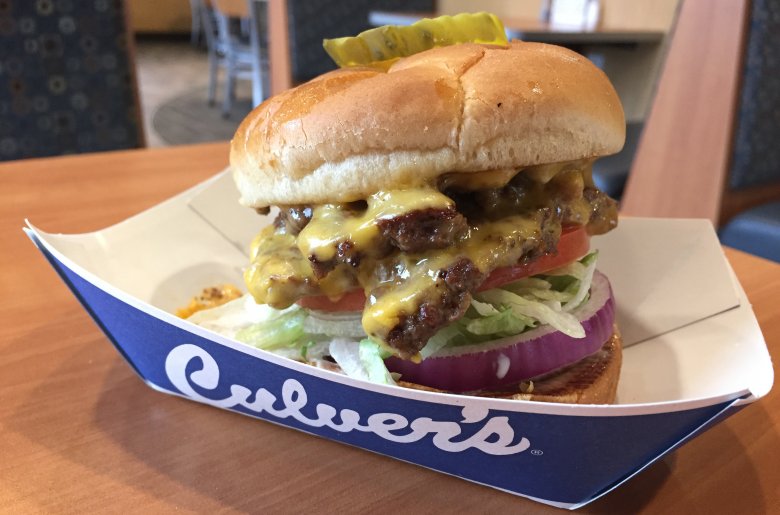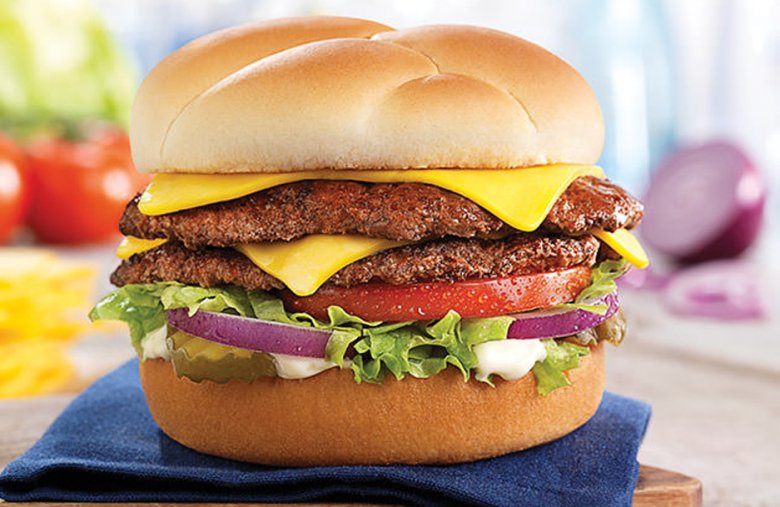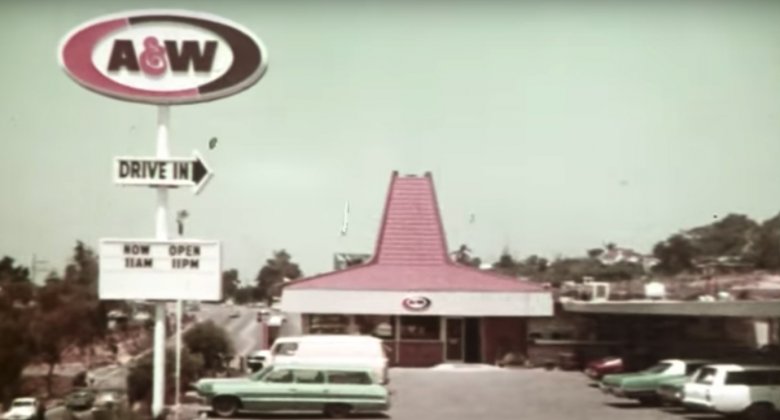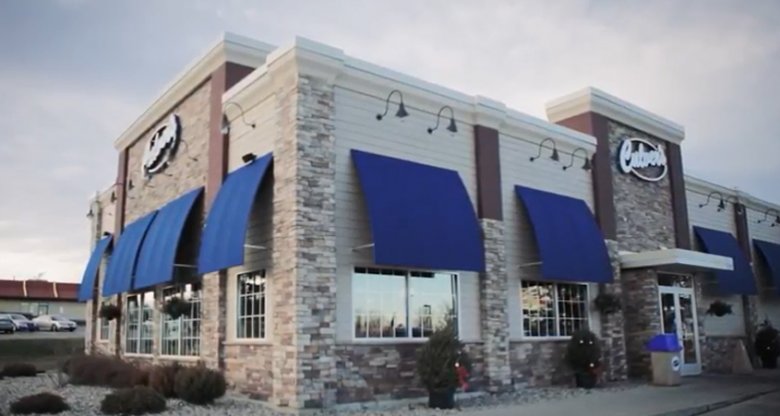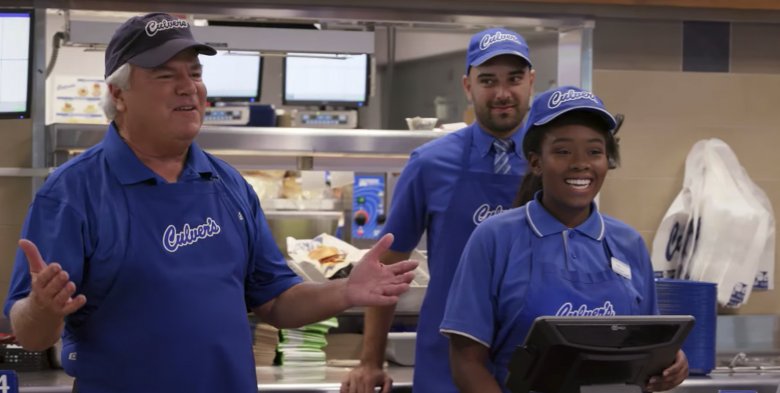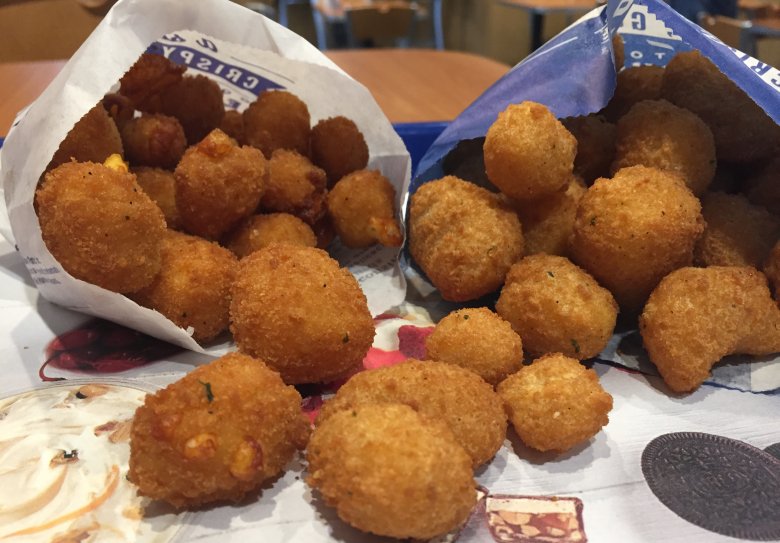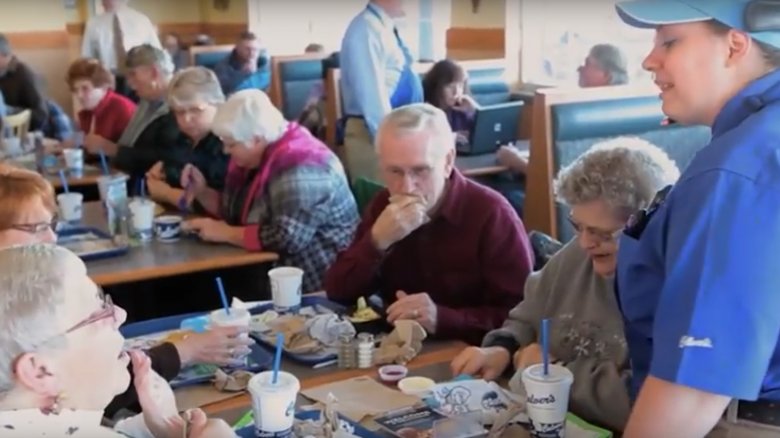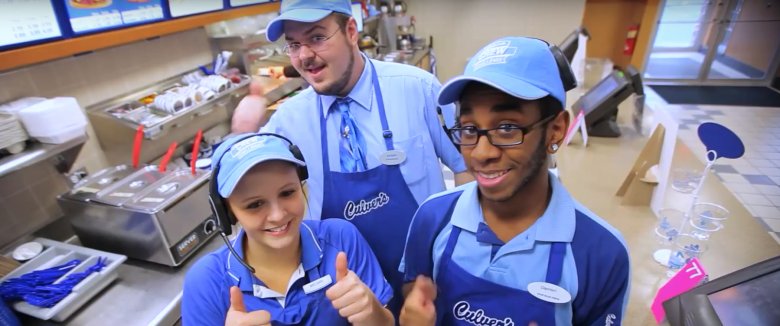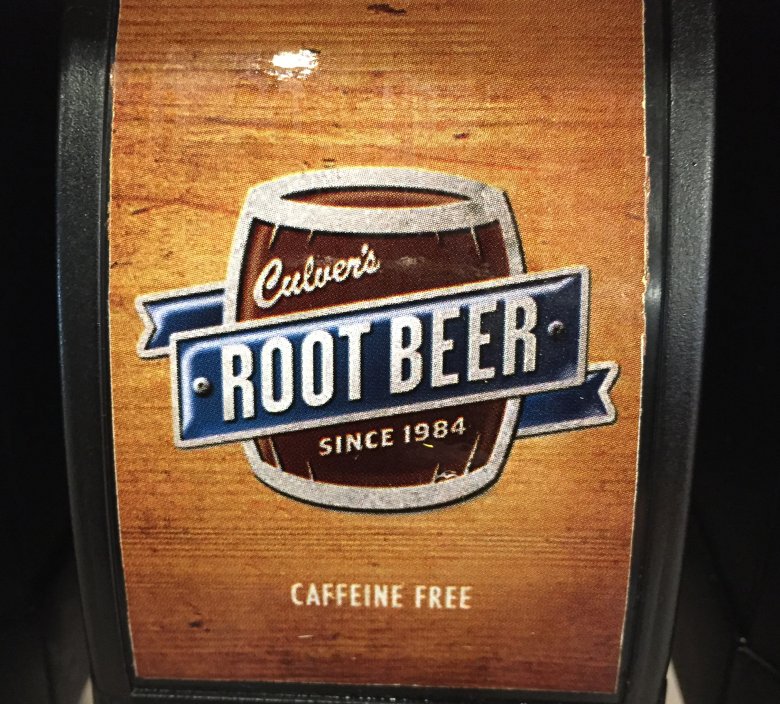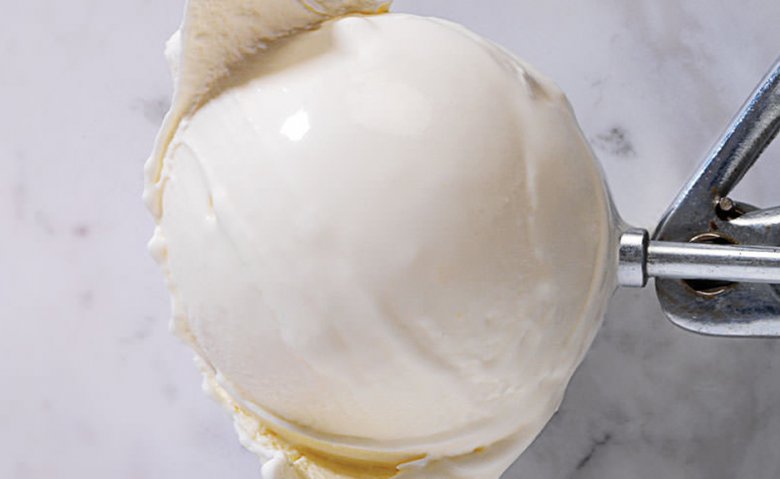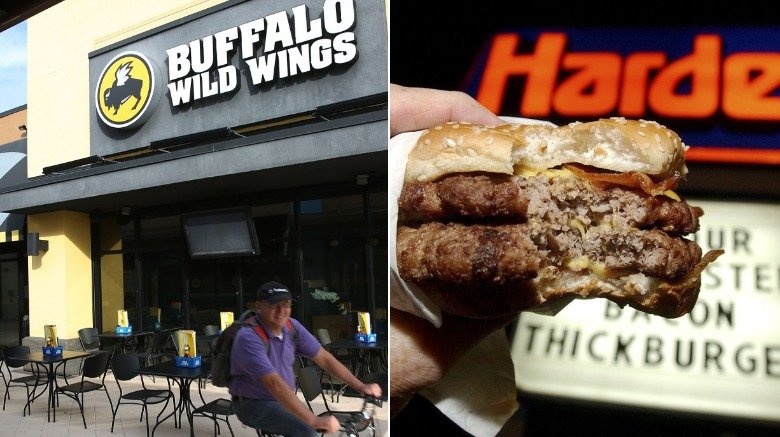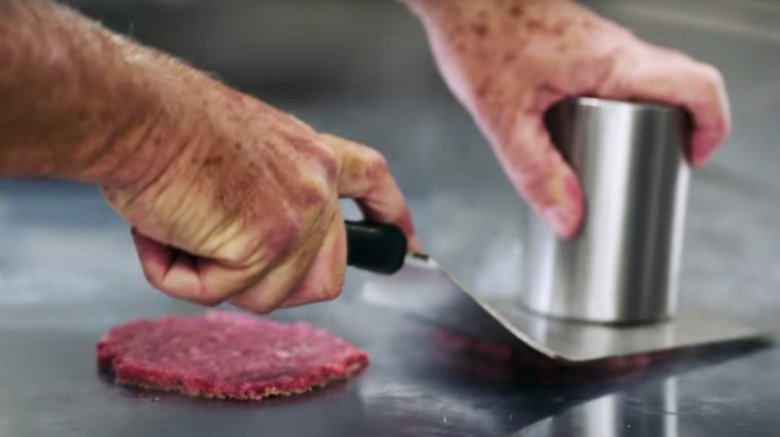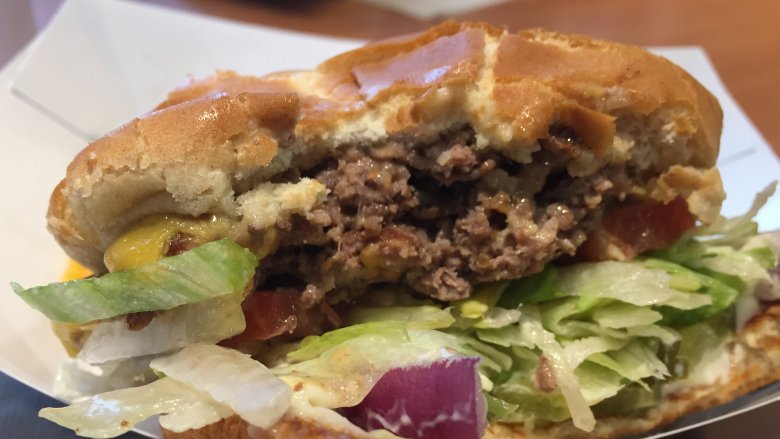The Untold Truth Of Culver's
The West Coast (and Texas) folks have a little something that the rest of the country doesn't with the In-n-Out Burger. The people of the Midwest just secretly smile, coyly knowing that they have a little gem of a restaurant themselves. Culver's made their bones serving up fresh burgers, awesome custards, and the kind of friendly smile you may think you can only find at a Chick-fil-A. But the Midwest's secret awesome burger joint isn't just a Midwest thing anymore — Culver's are expanding throughout the country (but not in California, take that In-n-Out!).
If you think the In-n-Out comparison is a bit bold, it's not. People love Culver's with as much gusto as the beloved California chain. If there's a Culver's near you, you're in on the game; if there's not, you're going to wish there was one. What's going on with Culver's and how did they go from one store in Wisconsin to one of the fastest growing, and most adored, quick serve joints? Take a gander at what's going on with Culver's.
Butterburger doesn't mean what you think
The catchy name "Butterburger" draws in imagery of a savory burger with a pat of butter rolling off of it like some snazzy steak at a high end joint. Yeah, that's not what it is at all. The butterburger name comes from a dollop of butter on the crown of the bun, to give it toasty, buttery flavor. Going along with their family feel, they source their butter from Alcam Creamery, a family-run Wisconsin based dairy distributor.
If that name fooled you, you're not the only one; but that's mainly because the name is a misnomer. There is a butter burger — and it's a Wisconsin thing. The best guess is that around 1936 Koll's Hamburgers opened in Green Bay serving a lop of butter on each burger. So despite the fact that butter burgers are a thing, and Culver's is from Wisconsin where butter burgers are, the Butterburger from Culver's isn't really a "butter burger."
It started with A&W
You can't say that George and Ruth Culver weren't risk takers, as they jumped feet first into a fast food chain in the 1960s — and it wasn't McDonald's. In 1961, the husband and wife purchased an A&W restaurant in Sauk City, Wisconsin. It should be noted that there were about 2,000 A&W's in the 60s, so it's not like they were purchasing some obscure chain store. They stuck with it for a while but the Culvers got out of the drive-in biz in 1968 and purchased a restaurant at Devil's Lake.
George and Ruth's son Craig graduated from University of Wisconsin in 1973, and after a few jobs, including working at McDonald's for four years, Craig convinced George and Ruth to take a shot at the quick serve game again. As fate would have it, they ended up purchasing the very spot where their A&W stood all those years before. In 1984, Culver's opened their first location.
They almost failed in their first year
Opening a restaurant isn't easy, no matter how much experience you have. You may have heard a stat that 90 percent of all restaurants fail in their first year; that's not exactly the case. Somewhere around 59 percent fail within their first three years of existence, and a bit less than 20 percent fail in year one. Why do new restaurants fail? The reasons can be varied and unique, but one thing is universal — competition. Culver's barely survived 1984 for one very specific reason, and that was Hardee's.
Despite the familiarity to the location, the very first Culver's opened right down the street from a Hardee's. In the first year Culver's sold a respectable $300,000 worth of product, which produced a negative $40,000. That's not good. Co-founder Craig Culver said, "If I'd been a better businessman, I would have sold." He's not wrong — but fortunately, Craig and the rest of the Culvers stuck with their mom-and-pop (literally!) joint, and after breaking even in year two, 1986 saw a profit of $100,000. From there, it was no stopping Culver's.
Their success rate is incredible
Since that dicey start, Culver's has leveled the ship and become one of the most successful franchises to own. In 2009, the national franchise failure rate ran around 17 percent, Culver's was doing much better, with their franchises having a failure rate of only 1.7 percent. How do they pull that off when other places you've heard of, such as Quiznos, ran at almost a 40 percent failure rate in a comparable time period? Well, they're a bit choosy like Chick-fil-A, and unlike some chains that grew too fast and ended up in Chapter 11 (like Boston Market), Culver's is taking the tortoise route to win the race. One of the ways that Culver's guaranteed their franchises did it the Culver's way was to teach them how a Culver does it. For many years, Craig Culver personally trained all the new franchisees, and he also scouted locations that would be suitable for 10,000 cars to pass by daily. Craig doesn't train all the stores like he used to, but a store owner told me that he still stops by and inspects the stores, and he'll even go as far as inviting customers back into the kitchen so they can see how the food is prepared — as this as this video demonstrates; that's legit, not something staged for the cameras, and he's done that at numerous stores. With a commitment like that it's no wonder they do so well!
Let's talk cheese curds
You may know the common cheese curd, most well-known for hanging out on french fries in Canada, and you can also make them at home if you're so inclined. Culver's cheese curds are a tiny bit different from the traditional way up north; their cheese curds are fried to a light golden brown, and remain pull-apart gooey. Culver's gets their cheese curds (using both white and yellow cheddar) from La Grander Hillside Dairy in Stanley, Wisconsin. There are way more white cheddar's than yellow cheddar's (at least in my orders), so it felt a bit special biting into a yellow cheddar, like finding a Wonka Golden Ticket. La Grander isn't just some run-of-the-mill cheese shoppe, they've been around since the early 1900s so you know the cheese is legit. You can get a dipping sauce with them, but honestly you don't need it — cheese curds are the side staple that really sets them apart from all the other quick serve restaurants out there.
The franchising fees aren't bad
If you think Culver's sounds pretty darn good and are thinking of diving in and taking a shot at a franchise, you'll be surprised to learn that it's really not that expensive to jump in — relatively speaking. McDonald's requires you to have $500,000 just laying around to even garner interest from them, and then as much as $2 million to get everything rolling. Culver's is paltry compared to that; with an initial fee of $55,000 and then $30,000 a year after that for 15 years, plus four percent of gross sales going back to corporate — much smaller than the 50 percent Chick-fil-A takes. There is one little catch, however — Culver's requires you to have $350,000 available in liquid assets (still less than McDonald's) and all in all you'll need about $1.6 million at least to get a Culver's off the ground — still not too shabby. That all sounds well and good, but let's cut to the chase; what will you make a year if you owned a Culver's?
Results vary from location to location, but in 2015 the average Culver's netted a bit over $1.5 million a store. If you do the math that'll leave you with a nice, tidy profit. Given that very high success rate, it's still a sound investment for a quick serve restaurant, which is why Culver's are growing so rapidly.
They're really growing
Has a Culver's popped up in your neck of the woods recently? That's not by accident. Culver's are stretching from Minnesota to Florida, and every state in between. As of now they aren't on the coasts, and a few places in the deep south, but they have plans to expand throughout the entire US. This isn't by surprise, Culver's finished second in a national poll as America's favorite burger only behind In-n-Out Burger. That's not because they're some plucky underdog — people really dig Culver's.
You can make the case that In-n-Out and Culver's are cut from the same cloth; both started as mom-and-pop burger joints and have a loyal fan base. Each grew in their respective states and then expanded slowly but carefully in neighboring states. They also are both regionalized, although Culver's has a bit wider swath than In-n-Out. As Culver's continues to expand, their popularity will just continue to rise.
The root beer is their own
Root beer. Some people love it, and other people wouldn't know good taste if it hit them upside the head in the form of a frost mug. You can make the case that root beer is a regional flavor — or at least more popular in certain regions. Root beer in particular is quite the hit in Wisconsin, so it makes sense that a business founded in the Cheese-head State by a former A&W owner would have root beer. But Culver's root beer isn't just any run-of-the-mill suds, they have their own formula. The root beer is from Rochester Root Beer, but it's their own proprietary recipe. They don't really mention that aloud publicize that fact, but a few insiders have noted it to me, and if you look hard enough on the internet you'll find it mentioned in passing. It has a nice sarsaparilla flavor, and comes off a tad bit sweet and very drinkable. But in case you don't trust my root beer expertise, there's a respectable root beer blog that paints a sanguine picture that sums it up, saying, "As far as fountain root beers go, this may be the best I have had." So, it's pretty good.
What is a custard?
Culver's pushes their custards; they mention it prominently in most literature and they feature a flavor of the day — some unique mix of their custard which is usually a wonderful pun or word play that's as delicious as their icy treat. But what exactly are we eating there? I mean, it's ice cream, right? Well, not exactly. Ice cream is milk and cream (and it's cold because duh), and frozen custard is milk, cream, and egg yolks. In order to be ice cream you need to be at least 10 percent milk fat by weight — so a custard doesn't qualify — hence the different name. But don't fret, you're used to not eating ice cream when you think you are; Dairy Queen is in the same boat and not technically ice cream. Custard is a big thing in the Midwest, so Culver's is just sticking with what they know best. You can think of it as ice cream if you really want to, but there is a taste difference — you'd probably notice it on that first bite, but it's close enough.
They are crazy charitable
Did you ever notice the correlation between popular fast food joints and charitable activities? Chick-fil-A and In-n-Out are both big into giving, so it's natural that Culver's, a restaurant that's in the same mold as those two popular chains, is also in the giving game. Culver's individual stores have stepped it up in natural disasters, such as a store in Texas rebuilding a barn after Hurricane Harvey and an Illinois store providing Thanksgiving dinners for those in need. Culver's once even donated 100 percent of their daily sales to provide a proper burial for a long-time employee.
The corporate arm does it's fair share as well, including providing scholarships for Culver's collegiate candidates. What started as a single $500 scholarship to a Culver's team member is now $4 million (and counting), including close to $500,000 worth of scholarships in 2017. If your local Culver's seems to be stocked with eager high schoolers, that could be part of the reason.
They aren't completely family owned anymore
Culver's began as a family business, with Ann and George Culver starting up the chain with their son Craig. Ann passed away in 2008, and George in 2011 at the age of 88. Son Craig and his wife aren't spring chickens anymore, but even prior to his parents passing, the Culver's were thinking of doing something to lighten the load a bit. It took a bit to get there, but in 2017 Culver's sold a minority share to Roark Capital Group, an Atlanta-based equity firm. Roark Capital probably doesn't ring a bell unless you collect investment firm trading cards, but you probably know a few of their other investment holdings. Roark is big in the quick-serve game, with holdings in the principal company that owns Arby's, Buffalo Wild Wings, and CKE Restaurants, which owns Carl's Jr/Hardee's. So the same company that almost put them under in year one is now a business partner, technically speaking. Oh the tangled web corporate ownership weaves.
How they do it
So what's the trick to making a Butterburger? A kindly manager told me the secret: They start with fresh beef — not frozen — and use a mix of three meats; sirloin, chuck, and plate. They also incorporate the puck method — which is a tried and true method that Steak-n-Shake, Five Guys, Shake Shack, and other famous recipes use. The cooking utensils are unique; they use a YUGE spatula — a solid piece, no holes in that sucker. They drop the puck on a flat top grill and then press it nice and flat to seal in the flavor — but they don't use brute force; they have a stainless steel cylinder that they use to put weight on the super large spatula to get the burger evenly flat. That's the true secret and how each burger comes out exactly the same. Culver's isn't a cheese in the middle place, like Five Guys, but rather rests it on top. As you know, the top bun gets a lop of butter on it and the toppings rest on the bottom bun. That's how the magic happens.
So how does it taste?
Are you familiar with the Butterburger? If so you know the drill. If you're not, let's break it down. Taste is subjective, but as the Chicago Tribune points out, they make a fantastic burger. Think Shake Shack with more flavor. Five Guys with better toppings. All the topping are always very fresh, and the condiment-to-bun ratio is about perfect. There's one thing that might throw you on your first Culver's order — they put a pickle on the top of the bun. Why? Well, because they can (I guess). The cheese doesn't come off wicked melty (unless you get a melt, because duh), and the subtle buttery toasty flavor of the bun just hits all the right spots.
Not a burger person? That's fine, the chicken is surprisingly delicious, and the pot roast sandwich, which in perspective isn't too unhealthy (keep in mind it's pot roast), is really unique and quite tasty. They go the crinkle cut fry route, and they're really really good. And there's the aforementioned custards and the plethora of flavors. Culver's is going to continue to grow; a 2017 ranking put Culver's as the number four favorite quick-serve chain in America. They were number two in burger joints only behind In-n-Out. The comparisons are real, Culver's is here to stay — and here to play with the big boys.
